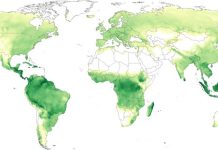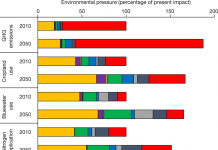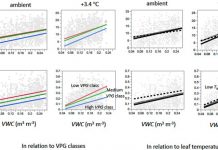【湿热促进氧化亚氮排放】Timothy J. GriffisZichong Chen John M. BakeraJeffrey D. Wood Dylan B. Millet Xuhui LeeRodney T. Venterea and Peter A. Turner. Nitrous oxide emissions are enhanced in a warmer and wetter world. PNAS 2017 doi: 10.1073-pnas.1704552114
Abstract
Nitrous oxide (N2O) has a global warming potential that is 300 times that of carbon dioxide on a 100-y timescale and is of major importance for stratospheric ozone depletion. The climate sensitivity of N2O emissions is poorly known which makes it difficult to project how changing fertilizer use and climate will impact radiative forcing and the ozone layer. Analysis of 6 y of hourly N2O mixing ratios from a very tall tower within the US Corn Belt—one of the most intensive agricultural regions of the world—combined with inverse modeling shows large interannual variability in N2O emissions (316 Gg N2O-N⋅y−1 to 585 Gg N2O-N⋅y−1). This implies that the regional emission factor is highly sensitive to climate. In the warmest year and spring (2012) of the observational period the emission factor was 7.5% nearly double that of previous reports. Indirect emissions associated with runoff and leaching dominated the interannual variability of total emissions. Under current trends in climate and anthropogenic N use we project a strong positive feedback to warmer and wetter conditions and unabated growth of regional N2O emissions that will exceed 600 Gg N2O-N⋅y−1 on average by 2050. This increasing emission trend in the US Corn Belt may represent a harbinger of intensifying N2O emissions from other agricultural regions. Such feedbacks will pose a major challenge to the Paris Agreement which requires large N2O emission mitigation efforts to achieve its goals.
—————————————————————————————————————————————–
【早期融雪增强了北方春季碳吸收】Jouni Pulliainen Mika Aurela Tuomas Laurila Tuula Aalto Matias Takala Miia Salminen Markku Kulmal Alan Barr Martin Heimann Anders Lindroth Ari Laaksonen Chris Derksen Annikki Mäkelä Tiina Markkanen Juha Lemmetyinen Jouni Susiluoto Sigrid Dengel Ivan Mammarella Juha-Pekka Tuovinen and Timo Vesala. Early snowmelt significantly enhances boreal springtime carbon uptake. PNAS 2017 doi: 10.1073-pnas.1707889114
Abstract
We determine the annual timing of spring recovery from space-borne microwave radiometer observations across northern hemisphere boreal evergreen forests for 1979–2014. We find a trend of advanced spring recovery of carbon uptake for this period with a total average shift of 8.1 d (2.3 d-decade). We use this trend to estimate the corresponding changes in gross primary production (GPP) by applying in situ carbon flux observations. Micrometeorological CO2 measurements at four sites in northern Europe and North America indicate that such an advance in spring recovery would have increased the January–June GPP sum by 29 g⋅C⋅m−2 [8.4 g⋅C⋅m−2 (3.7%)-decade]. We find this sensitivity of the measured springtime GPP to the spring recovery to be in accordance with the corresponding sensit







